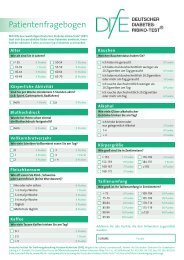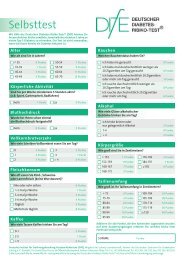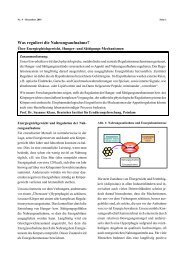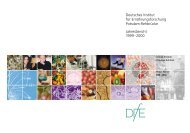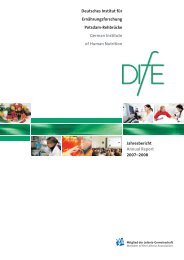BB - DIfE
BB - DIfE
BB - DIfE
Erfolgreiche ePaper selbst erstellen
Machen Sie aus Ihren PDF Publikationen ein blätterbares Flipbook mit unserer einzigartigen Google optimierten e-Paper Software.
42<br />
�4 DNA adducts (1–5), detected by the 32Ppostlabeling<br />
technique, in human buccal<br />
mucosa before (A) and after (B) chewing<br />
raw broccoli, as well as (C) in endogenous<br />
DNA after a 2-h incubation of broccoli<br />
homogenate. 0, point of sample application.<br />
adducts in the buccal mucosa (Fig. �4 ).<br />
Rats fed raw broccoli showed one of<br />
these characteristic adducts (adduct<br />
spot 3 in Fig. �4 ) in all tissues investigated<br />
(including gut, liver, lung, and kidney)<br />
and sometimes also the minor<br />
adduct spot 5; the adducts were absent<br />
in control rats. We are attempting<br />
to identify the chemical structure of<br />
this adduct and its causing agent. We<br />
are studying the influence of the<br />
preparation (e.g. cooking) and the variety<br />
of broccoli (and other Brassica vegetables)<br />
on the formation of DNA<br />
adducts in rat tissues. Likewise, the<br />
mutagenic potential of the adduct<br />
remains to be determined under in vivo<br />
conditions, as well as the possible relationship<br />
with protective effects of<br />
Brassica plants. It is known that chemoprevention<br />
by Brassica is due, at least in<br />
part, to the induction of defense systems<br />
against reactive molecules. Such<br />
an induction makes most sense, if the<br />
inducer has the potential to damage the<br />
organism. In case of such a two-sided<br />
activity of a broccoli constituent, the<br />
dose could be important for the balance<br />
of favorable and adverse effects.<br />
Alternatively, these effects may be due<br />
to different agents, offering the possibility<br />
to enhance beneficial effects by<br />
choosing appropriate plant varieties<br />
and cooking procedures.<br />
In co-operation with the Department<br />
Biochemistry of Micronutrients we<br />
intend to specify effective exposure levels,<br />
active components, and mechanisms<br />
involved in protective effects of<br />
Brassica vegetables and to explore relationships<br />
to possible adverse effects.<br />
In co-operation with the Department<br />
of Gastrointestinal Microbiology we<br />
could demonstrate that various secondary<br />
metabolites from vegetables and<br />
fruit (e.g., glucobrassicin from broccoli<br />
und arbutin from pears) can be bioactivated<br />
to DNA-reactive metabolites by<br />
enzymes from specific species of intestinal<br />
bacteria.<br />
A<br />
0<br />
�4 DNA-Addukte in humaner Mundschleimhaut<br />
vor (A) und nach (B) dem Kauen von<br />
rohem Broccoli, und zum Vergleich in Broccoli-<br />
DNA (C) nach zweistündiger Inkubation von<br />
Broccoli-Homogenat. Nach Verdau der DNA<br />
wurden die modifizierten Nukleotide mit<br />
32 P-Phosphat markiert, zweidimensional auf<br />
Dünnschichtplatten chromatografiert und<br />
autoradiografisch visulaisiert. 0, Auftragstelle;<br />
1–5, Addukte.<br />
(z.B. Glucobrassicin aus Broccoli und<br />
Arbutin aus der Birne) durch Enzyme spezifischer<br />
Darmbakterienarten zu DNAreaktiven<br />
Substanzen umgesetzt werden<br />
können.<br />
B<br />
0<br />
C<br />
0<br />
1<br />
1<br />
2<br />
2<br />
5<br />
5<br />
3<br />
3<br />
Technische Mitarbeiterinnen<br />
Sabine Braune<br />
Christine Gumz<br />
Andrea Katschak<br />
Brigitte Knuth<br />
Elisabeth Meyer<br />
Martina Scholtyssek<br />
Jutta Schwenk<br />
4<br />
4





